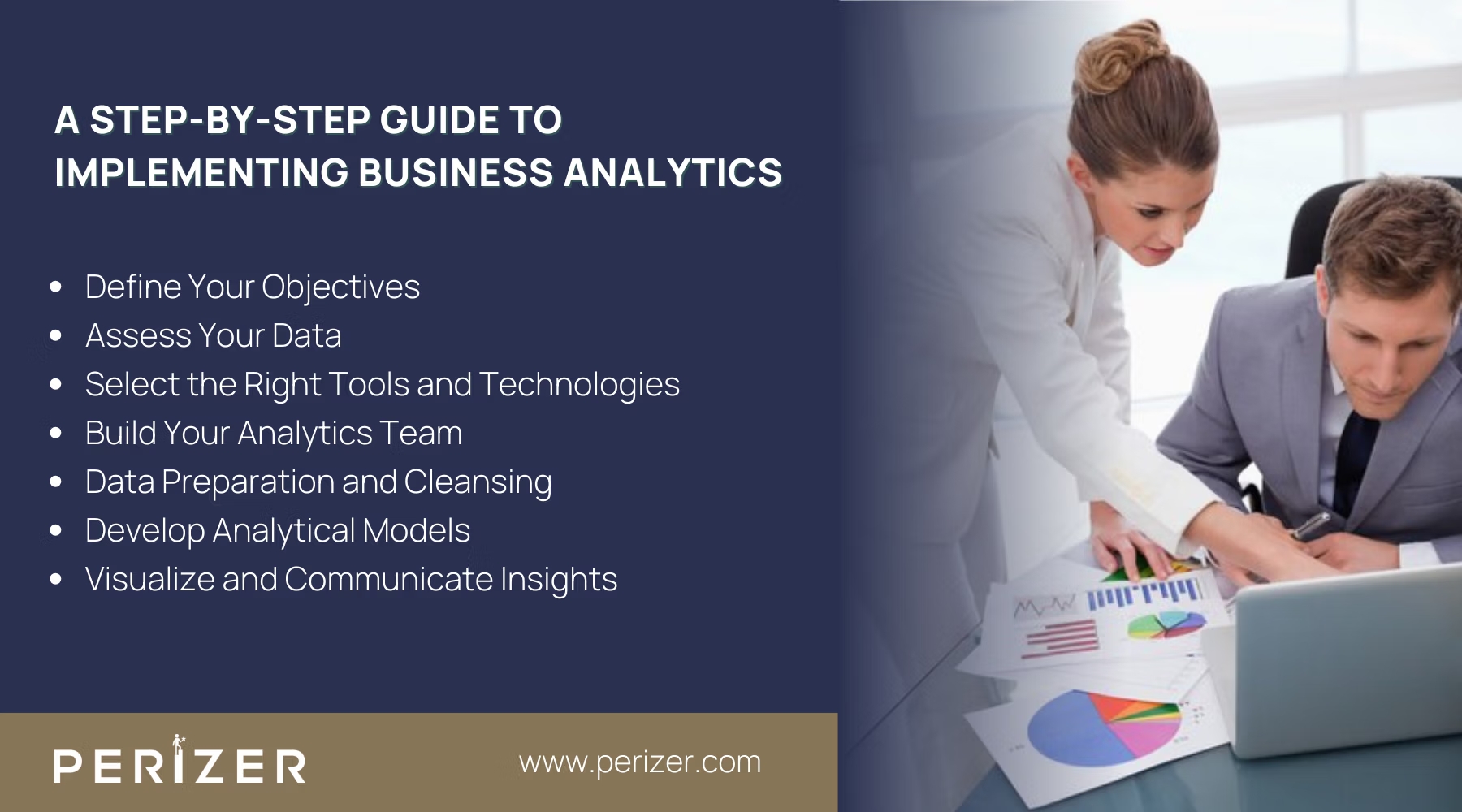A Step-by-Step Guide to Implementing Business Analytics
Learn how to turn your business data into actionable insights with this step-by-step guide, helping you make smarter decisions and drive growth.

Business analytics is all about using data, statistical analysis, and technology to make smarter business decisions. It helps businesses identify trends, improve customer experiences, and optimize operations. Today, business analytics is more than an advantage - it’s a necessity in the fast-growing market. Without it, you could be missing out on opportunities that could take your business to the next level.
This guide will show you how to effectively implement business analytics, turning your data into powerful insights that can drive your company’s success.
Step-by-Step Guide to Implementing Business Analytics

1. Define Your Objectives
The first step in any successful analytics journey is to define your objectives clearly. Imagine going on a road trip without a destination confusing, right? The same principle applies here. You need to know exactly what you want to achieve with your analytics efforts. Do you want to improve customer satisfaction, streamline operations, or increase revenue? Knowing your goals will help you focus your efforts and resources effectively.
How to Set Clear Objectives?
To set clear objectives for your business analytics, start by making sure your goals align with your company's overall strategy. This ensures that your analytics efforts are supporting your organization's broader mission. Engage with key stakeholders from different departments to understand their needs and expectations. This will help you create goals that are both relevant and impactful.
Use the SMART criteria to define your objectives: make them Specific, Measurable, Achievable, Relevant, and Time-bound. For example, instead of a vague goal like "improve sales," aim for something more precise, like a "15% increase in sales over the next quarter."
By following these steps, you'll ensure your analytics efforts are well-directed and effective in driving your organization's growth and success.
2. Assess Your Data
Once you know what you want to achieve, it's time to take a closer look at your data. You need to understand the quality, relevance, and accessibility of your data. It’s like checking the ingredients before cooking; you need to know what you have and what you might be missing.
How to Conduct a Data Audit?
When assessing your data for business analytics, start by identifying all potential data sources, such as CRM systems, ERP systems, social media platforms, and third-party providers. Knowing what data you have and where it resides is essential for effective analysis. Next, evaluate the quality of this data by checking for accuracy, completeness, and consistency. Look for any gaps or inconsistencies that could affect your analysis.
Ensure that the right people can access the data they need by breaking down data silos and setting up data-sharing protocols. It's crucial to make sure that the most relevant datasets are prioritized in your analytics efforts. This way, you can focus on the data that truly supports your business objectives and use it to drive meaningful insights.
3. Select the Right Tools and Technologies
Now that you know your objectives and have assessed your data, it's time to select the right tools and technologies to support your analytics efforts. The right tools can make or break your analytics success, so choose wisely.
How to Choose the Right Tools?
When selecting tools for business analytics, start by evaluating their features and capabilities. Make sure the tools offer predictive analytics, machine learning, and data visualization, aligning with your business goals. Consider ease of use tools should be user-friendly so your team can utilize them effectively.
Assess scalability, ensuring the tools can handle more data as your business grows. Look at integration capabilities to ensure seamless data flow with existing systems. Finally, consider the total cost, including licensing, implementation, and training, to ensure they fit your budget and expected ROI.
For example, Tableau is great for data visualization with interactive dashboards. Power BI integrates well with Microsoft products for data modeling and visualization, while SAS offers predictive modeling and machine learning, popular among data scientists. Choosing the right tool can significantly improve your business analytics capabilities, making data-driven decision-making more efficient.
4. Build Your Analytics Team
Implementing business analytics requires a skilled and diverse team. You need individuals with expertise in data science, statistics, business strategy, and domain knowledge to turn data into insights and actionable recommendations.
How to Build an Effective Analytics Team?
To build an effective analytics team, start by clearly defining the roles you need, like data engineers, data scientists, and business analysts, and outline their responsibilities. Hire skilled professionals with strong analytical skills and technical expertise. Encourage teamwork by fostering a culture of open communication and knowledge sharing.
Provide opportunities for continuous learning to keep everyone updated on the latest tools and trends. Finally, involve stakeholders across the organization to ensure that your analytics goals align with the company's objectives. This approach will create a cohesive team that delivers valuable insights.
5. Data Preparation and Cleansing
Data preparation is a critical step in the analytics process. Clean, transform, and integrate your data to ensure it's ready for analysis. Proper data preparation lays the groundwork for accurate and reliable insights.
How to Prepare Your Data?
To prepare your data for analysis, start by cleaning it. This involves addressing any duplicates, missing values, and outliers using techniques like imputation and normalization. Then, transform your data into a suitable format, which might involve aggregating, filtering, or reformatting datasets to fit your analytics goals.
Integrate data from multiple sources into a centralized repository to get a comprehensive view. Establish data governance policies to maintain data quality, consistency, and security. Finally, use Extract, Transform, and Load (ETL) processes to streamline data preparation and ensure it’s ready for analysis.
6. Develop Analytical Models
Once your data is prepared, it's time to develop analytical models that provide valuable insights. Use advanced statistical techniques and machine learning algorithms to uncover patterns, trends, and relationships within your data.
How to Develop Effective Analytical Models:
First, decide what you want your models to achieve, like predicting trends, finding customer groups, or improving processes. Then, choose the right algorithms based on your goals and data. Focus on how accurate, easy to understand, and efficient they are.
Build and test your models with historical data, trying different algorithms to see what works best. Use metrics like accuracy and precision to evaluate performance and ensure they meet your standards.
Once the models are ready, deploy them. Monitor their performance and make any needed adjustments to keep them effective.
7. Visualize and Communicate Insights
Data visualization is key to communicating insights and findings clearly and compellingly. Create visualizations that enable stakeholders to explore data and gain actionable insights at a glance.
How to Visualize Data Effectively?
To visualize data effectively, start by choosing the right tools like Tableau, Power BI, or D3.js to create interactive and dynamic visuals. Tailor these visualizations to fit your audience’s needs, considering what different groups within your organization require.
Keep visuals clear and concise, focusing on key insights without clutter. Craft a narrative that guides stakeholders through your findings, using visuals to tell the story your data presents. Allow stakeholders to explore data by providing options for filtering, sorting, and drilling down into specific details for deeper insights.
Conclusion
Implementing business analytics is a powerful way to turn your data into a strategic asset that drives growth and decision-making in your organization. By setting clear objectives, assessing data quality, choosing the right tools, and building a skilled team, you lay the groundwork for successful analytics initiatives.
Preparing your data, developing powerful analytical models, and visualizing insights effectively will help you uncover valuable patterns and trends. This step-by-step approach ensures that your business can make data-driven decisions, stay ahead of the competition, and achieve its goals.
FOCUSED, FAST, GOVERNMENT READY
Stay Tuned With Our Latest Insights

Staff Augmentation
Learn how to select the perfect IT outsourcing partner to promote your team’s capabilities, improve productivity, and drRead more...

Staff Augmentation
Find the perfect staff augmentation partner by aligning your goals, evaluating expertise, managing costs, and ensuring aRead more...

Cyber Security
We focus on understanding the needs, behaviors, and expectations of your users through extensive user research. This infRead more...